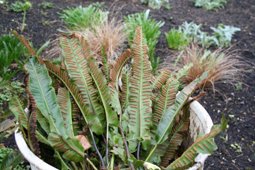This year we have made time to grow a few indoor crops in our Victorian greenhouse and vinery, including Cantaloupe melons (Blenheim Orange), Ridge cucumbers (Marketmore) and 3 different varieties of Tomatoes (Gardeners Delight, Sakura F1 and Brandywine)

We sowed our Tomatoes on 6th March in a heated propagator, by 21st March they were ready to prick out into larger, individual pots.
The trick with tomatoes is to keep them moving itno a bigger pot as soon as the roots have filled the pot - without letting them get potbound.

Three pot sizes later.... and they also needed tying in to a cane, to stop them falling over. We create a neat figure of eight using string, and not too tight as the stem will expand as the plant grows.
All our varieties are cordon tomatoes or indeterminate, which means the main shoot will continue to grow - given its own way. However, the growing tips will be pinched out after a certain number of fruit trusses have formed depending upon whether it is growing in the greenhouse, vinery or outside.

With this type of tomato, the side shoots need removing so growth is directed into the developing fruit, not excess foliage. At the axil of each leaf the tiny shoot is just pinched out with my fingers. If you miss one, it will get quite large quite quickly, so be sure to keep a eye on them!
As they need watering most days in the warm weather it is easy to look along the stem each time to see if any need removing - and you enjoy that lovely scent of tomatoes each time it is bruised - takes me back to my childhood each and every time!
Constant watering is best - they dont like being either waterlogged or too dry, but a little every day ensures the fruit will not be prone to splitting. Also, we spray a few whitefly with insecticidal soft soap on the tips.

10th of May, so about 2 months after they were first sown, the first exciting tiny green tomatoes are developing now - we now start feeding every two weeks with a high potash feed to ensure the best quality crop.
Plenty of high temperatures and sunshine means the fruit grow quickly and start to ripen, the first to turn red is Sakura F1, and looks like Gardeners Delight will be next, all by the 8th June. Picked fresh and warm from the plant, a quick wipe on my sleeve - I really should just check if they are fully ripe yet!!!

 Then the sun starts to seep through the murk and walking around the garden looks completely different - I guess you are only focusing on the ground as these is a white blanket above, so details seem to jump out at you much more. There is little you can do outside on days like these where the frost doesnt lift, so its a good chance for us to tidy the greenhouses and vinery.
Then the sun starts to seep through the murk and walking around the garden looks completely different - I guess you are only focusing on the ground as these is a white blanket above, so details seem to jump out at you much more. There is little you can do outside on days like these where the frost doesnt lift, so its a good chance for us to tidy the greenhouses and vinery.






















































